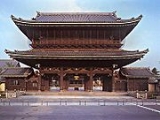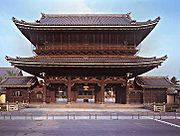
Higashi Honganji
Encyclopedia

Japan
Japan is an island nation in East Asia. Located in the Pacific Ocean, it lies to the east of the Sea of Japan, China, North Korea, South Korea and Russia, stretching from the Sea of Okhotsk in the north to the East China Sea and Taiwan in the south...
and abroad, the other being Nishi Honganji
Nishi Honganji
or the "Western Temple of the Original Vow", is one of two temple complexes of Jodo Shinshu in Kyoto, the other being Higashi Honganji...
(or, 'The Western Temple of the Original Vow'). It is also the name of the head temple in Kyoto
Kyoto
is a city in the central part of the island of Honshū, Japan. It has a population close to 1.5 million. Formerly the imperial capital of Japan, it is now the capital of Kyoto Prefecture, as well as a major part of the Osaka-Kobe-Kyoto metropolitan area.-History:...
, a collection of buildings built in 1895 after a fire burned down the previous temple.
Higashi Honganji was established in 1602 by the Shogun
Shogun
A was one of the hereditary military dictators of Japan from 1192 to 1867. In this period, the shoguns, or their shikken regents , were the de facto rulers of Japan though they were nominally appointed by the emperor...
Tokugawa Ieyasu
Tokugawa Ieyasu
was the founder and first shogun of the Tokugawa shogunate of Japan , which ruled from the Battle of Sekigahara in 1600 until the Meiji Restoration in 1868. Ieyasu seized power in 1600, received appointment as shogun in 1603, abdicated from office in 1605, but...
when he split the Shin sect in two (Nishi Honganji being the other) in order to diminish its power.
During the Twentieth Century it was troubled by political disagreements, financial scandals and family disputes, and has subsequently fractured into a number of further sub-divisions. The largest Higashi Honganji grouping, the Shinshu Otaniha
Otani-ha
Otani-ha is a Japanese Buddhist movement. It belongs to Jōdo Shinshū. Otani University in Kyoto belongs to Otani-ha. The headquarters of Otani-ha are in Kyoto as well. The mother temple of Otani-ha is Higashi Honganji. The movement belongs to Shin Buddhism. -See also:*Gedatsukai*Hommon...
has approximately 5.5 million members, according to statistics. However within this climate of instability the Higashi Honganji also produced a significant number of extremely influential thinkers, such as Soga Ryojin
Soga Ryojin
was an influential thinker in the Higashi Honganji Jōdo Shinshū Buddhist tradition, and a President of Otani University. A disciple of Kiyozawa Manshi he developed an approach to Jōdo Shinshū doctrine that at times brought him into serious conflict with more conservative elements of the tradition...
, Kiyozawa Manshi
Kiyozawa Manshi
was a Japanese Shin Buddhist reformer of samurai background who studied at Tokyo University in Western philosophy under the American philosopher Ernest Fenollosa....
, Kaneko Daiei
Kaneko Daiei
was a Japanese born son of a Shin Buddhist priest from Niigata Prefecture. He was a student Kiyozawa Manshi and had taught for several years at Otani University. In 1928 he was excommunicated from Jodo Shinshu for having charged the organization had become shrouded in materialism...
and Haya Akegarasu amongst others.


